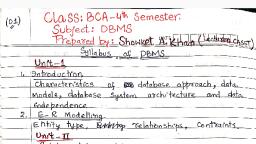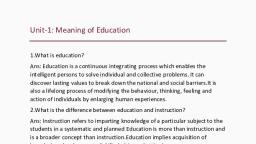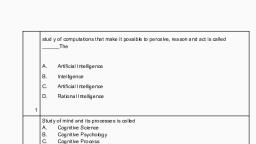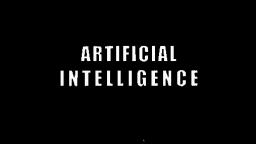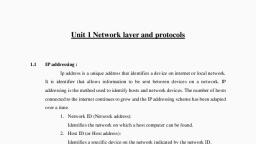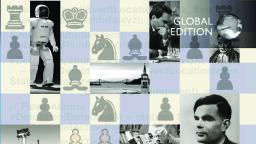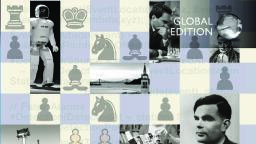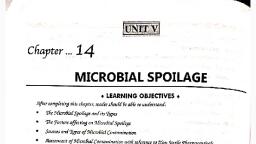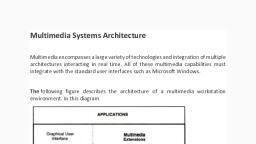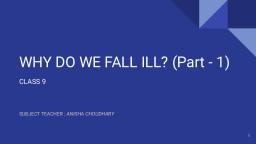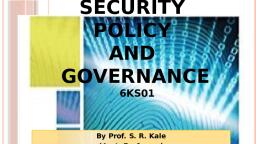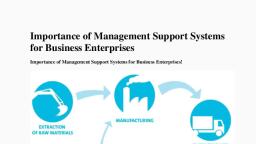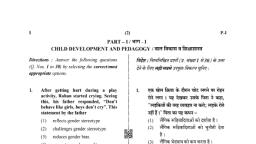Page 1 :
Subject: Artificial Intelligence, BCA (6th Semester), Prepared by: Showket A. Khan, (Lecturer at CASET College of Computer Science), UNIT –I (INTRODUCTION), , , A branch of Computer Science named Artificial Intelligence pursues creating the, computers or machines as intelligent as human beings., , , , Artificial Intelligence is composed of two words Artificial and Intelligence,, where Artificial defines "man-made," and intelligence defines "thinking, power", hence AI means "a man-made thinking power.", , What is Artificial Intelligence?, , , According to the father of Artificial Intelligence, John McCarthy, it is “The science and, engineering of making intelligent machines, especially intelligent computer programs”., , "It is a branch of computer science by which we can create intelligent machines, which can behave like a human, think like humans, and able to make decisions.", , Applications of Artificial Intelligence, AI has been dominant in various fields such as −, , , Gaming – Artificial Intelligence plays crucial role in strategic games such as chess,, poker, tic-tac-toe, etc., where machine can think of large number of possible positions, based on heuristic knowledge., , , , Natural Language Processing − It is possible to interact with the computer that, understands natural language spoken by humans., , , , Expert Systems − There are some applications which integrate machine, software, and, special information to impart reasoning and advising. They provide explanation and, advice to the users., , , , Vision Systems − these systems understand, interpret, and comprehend visual input on, the computer. For example, Police use computer software that can recognize the face of, criminal with the stored portrait made by forensic artist., , , , Speech Recognition − Some intelligent systems are capable of hearing and, comprehending the language in terms of sentences and their meanings while a human, talks to it. It can handle different accents, slang words, noise in the background, change, in human’s noise due to cold, etc., , , , Handwriting Recognition − the handwriting recognition software reads the text written, on paper by a pen or on screen by a stylus. It can recognize the shapes of the letters, and convert it into editable text., , , , Intelligent Robots − Robots are able to perform the tasks given by a human. They have, sensors to detect physical data from the real world such as light, heat, temperature,, movement, sound, and pressure. They have efficient processors, multiple sensors and, huge memory, to exhibit intelligence. In addition, they are capable of learning from their, mistakes and they can adapt to the new environment.
Page 2 :
History of Artificial Intelligence, The history of AI during 20th century −, Year, , Milestone / Innovation, , 1923, , Karel Čapek play named “Rossum's Universal Robots” (RUR) opens in, London, first use of the word "robot" in English., , 1943, , Foundations for neural networks laid., , 1945, , Isaac Asimov, a Columbia University alumni, coined the term Robotics., , 1950, , Alan Turing introduced Turing Test for evaluation of intelligence and, published Computing, Machinery and, Intelligence. Claude, Shannon, published Detailed Analysis of Chess Playing as a search., , 1956, , John McCarthy coined the term Artificial Intelligence. Demonstration of the, first running AI program at Carnegie Mellon University., , 1958, , John McCarthy invents LISP programming language for AI., , 1964, , Danny Bobrow's dissertation at MIT showed that computers can understand, natural language well enough to solve algebra word problems correctly., , 1965, , Joseph Weizenbaum at MIT built ELIZA, an interactive problem that carries, on a dialogue in English., , 1969, , Scientists at Stanford Research Institute Developed Shakey, a robot,, equipped with locomotion, perception, and problem solving., , 1973, , The Assembly Robotics group at Edinburgh University built Freddy, the, Famous Scottish Robot, capable of using vision to locate and assemble, models., , 1979, , The first computer-controlled autonomous vehicle, Stanford Cart, was built.
Page 3 :
1985, , Harold Cohen created and demonstrated the drawing program, Aaron., Major advances in all areas of AI −, , , , , 1990, , , , , , , , Significant demonstrations in machine learning, Case-based reasoning, Multi-agent planning, Scheduling, Data mining, Web Crawler, natural language understanding and translation, Vision, Virtual Reality, Games, , 1997, , The Deep Blue Chess Program beats the then world chess champion, Garry, Kasparov., , 2000, , Interactive robot pets become commercially available. MIT displays Kismet, a, robot with a face that expresses emotions. The robot Nomad explores remote, regions of Antarctica and locates meteorites., , What is Intelligence?, The ability of a system to calculate, reason, perceive relationships and analogies, learn from, experience, store and retrieve information from memory, solve problems, comprehend complex, ideas, use natural language fluently, classify, generalize, and adapt new situations., , What is Intelligence Composed of?, The intelligence is intangible. It is composed of −, , , , , , , Reasoning, Learning, Problem Solving, Perception, Linguistic Intelligence
Page 4 :
Reasoning − It is the set of processes that enables us to provide basis for judgement, making, decisions, and prediction., Learning − It is the activity of gaining knowledge or skill by studying, practising, being taught,, or experiencing something., Problem Solving − It is the process in which one perceives and tries to arrive at a desired, solution from a present situation by taking some path, which is blocked by known or unknown, hurdles. Problem solving also includes decision making, which is the process of selecting the, best suitable alternative out of multiple alternatives to reach the desired goal are available., Perception − It is the process of acquiring, interpreting, selecting, and organizing sensory, information. Perception presumes sensing. In humans, perception is aided by sensory organs., In the domain of AI, perception mechanism puts the data acquired by the sensors together in a, meaningful manner., Linguistic Intelligence − It is one’s ability to use, comprehend, speak, and write the verbal, and written language. It is important in interpersonal communication., , Turing Test, The success of an intelligent behaviour of a system can be measured with Turing Test., Two persons and a machine to be evaluated participate in the test. Out of the two persons, one, plays the role of the tester. Each of them sits in different rooms. The tester is unaware of who, is machine and who is a human. He interrogates the questions by typing and sending them to, both intelligences, to which he receives typed responses., This test aims at fooling the tester. If the tester fails to determine machine’s response from the, human response, then the machine is said to be intelligent., , What are Agent and Environment?, An agent is anything that can perceive its environment through sensors and acts upon that, environment through effectors.
Page 5 :
Agent Terminology, , , Performance Measure of Agent − It is the criteria, which determines how successful an, agent is., , , , Behaviour of Agent − It is the action that agent performs after any given sequence of, percepts., , , , Percept − It is agent’s perceptual inputs at a given instance., , , , Percept Sequence − It is the history of all that an agent has perceived till date., , , , Agent Function − It is a map from the precept sequence to an action., , , , Agent Program - an implementation of an agent function., , , , Agent Architecture - the machinery that an agent executes on., , , , Agent = Architecture + Agent Program., , Rationality, Rationality is nothing but status of being reasonable, sensible, and having good sense of, judgment., , What is Ideal Rational Agent?, An ideal rational agent is the one, which is capable of doing expected actions to maximize its, performance measure, on the basis of −, , , , Its percept sequence, Its built-in knowledge base
Page 6 :
Rationality of an agent depends on the following:, , , The performance measures, which determine the degree of success., , , , Agent’s Percept Sequence till now., , , , The agent’s prior knowledge about the environment., , , , The actions that the agent can carry out., , A rational agent always performs right action, where the right action means the action that, causes the agent to be most successful in the given percept sequence. The problem that the, agent solves is characterized by Performance Measure, Environment, Actuators, and Sensors, (PEAS)., , Types of Agents:, (1) Simple Reflex Agents, (2) Model Based Reflex Agents, (3) Goal Based Agents, (4) Utility Based Agents, (5) Learning Agents, , Simple Reflex Agents, , , , , They choose actions only based on the current percept., They are rational only if a correct decision is made only on the basis of current precept., Their environment is completely observable., , Condition-Action Rule − It is a rule that maps a state (condition) to an action., , Model Based Reflex Agents, They use a model of the world to choose their actions. They maintain an internal state., Model − knowledge about “how the things happen in the world”., Internal State − It is a representation of unobserved aspects of current state depending on, percept history.
Page 7 :
Updating the state requires the information about −, , , , How the world evolves., How the agent’s actions affect the world., , Goal Based Agents, They choose their actions in order to achieve goals. Goal-based approach is more flexible than, reflex agent since the knowledge supporting a decision is explicitly modelled, thereby allowing, for modifications., Goal − It is the description of desirable situations., , Utility Based Agents, They choose actions based on a preference (utility) for each state., Goals are inadequate when −, , , There are conflicting goals, out of which only few can be achieved.
Page 8 :
, , Goals have some uncertainty of being achieved and you need to weigh likelihood of, success against the importance of a goal., , Learning Agents, o, , A learning agent in AI is the type of agent which can learn from its past experiences,, or it has learning capabilities., , o, , It starts to act with basic knowledge and then able to act and adapt automatically, through learning., , o, , A learning agent has mainly four conceptual components, which are:, a. Learning element: It is responsible for making improvements by learning, from environment, b. Critic: Learning element takes feedback from critic which describes that how, well the agent is doing with respect to a fixed performance standard., c. Performance element: It is responsible for selecting external action, d. Problem generator: This component is responsible for suggesting actions, that will lead to new and informative experiences., , o, , Hence, learning agents are able to learn, analyze performance, and look for new, ways to improve the performance.
Page 9 :
Properties of Environment, The environment has many properties −, , , Discrete / Continuous − If there are a limited number of distinct, clearly defined, states, of the environment, the environment is discrete (For example, chess); otherwise it is, continuous (For example, driving)., , , , Fully Observable / Partially Observable − If it is possible to determine the complete, state of the environment at each time point from the percepts it is fully observable;, otherwise it is partially observable., , , , Static / Dynamic − If the environment does not change while an agent is acting, then it, is static; otherwise it is dynamic., , , , Single agent / Multiple agents − The environment may contain other agents which may, be of the same or different kind as that of the agent., , , , Accessible / Inaccessible − If the agent’s sensory apparatus can have access to the, complete state of the environment, then the environment is accessible to that agent., , , , Deterministic / Non-deterministic − If the next state of the environment is completely, determined by the current state and the actions of the agent, then the environment is, deterministic; otherwise it is non-deterministic., , , , Episodic / Non-episodic − In an episodic environment, each episode consists of the, agent perceiving and then acting. The quality of its action depends just on the episode, itself. Subsequent episodes do not depend on the actions in the previous episodes., Episodic environments are much simpler because the agent does not need to think, ahead.

